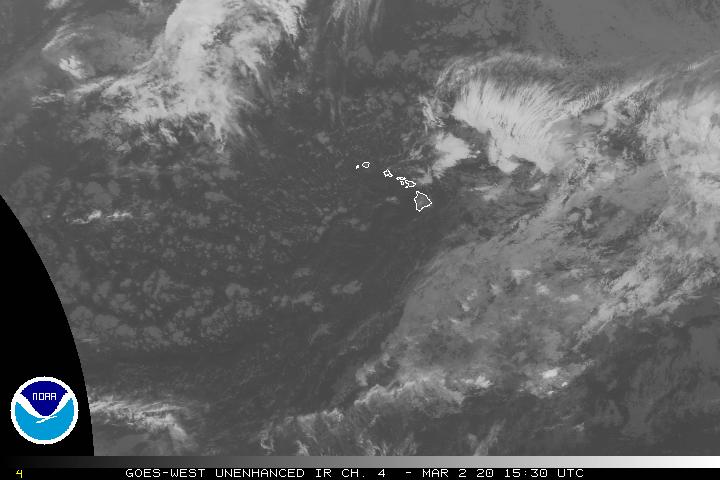Air Temperatures – The following high temperatures (F) were recorded across the state of Hawaii Tuesday…along with the low temperatures Tuesday:
87 – 77 Lihue, Kauai
87 – 76 Honolulu, Oahu
86 – 76 Molokai
89 – 75 Kahului AP, Maui
91 – 79 Kailua Kona
82 – 73 Hilo AP, Hawaii
Here are the latest 24-hour precipitation totals (inches) for each of the islands as of Tuesday evening:
0.14 Mount Waialeale, Kauai
0.03 Waihee Pump, Oahu
0.00 Molokai
0.00 Lanai
0.00 Kahoolawe
0.04 West Wailuaiki, Maui
0.31 Kamuela Upper, Big Island
The following numbers represent the strongest wind gusts (mph) as of Tuesday evening:
30 Port Allen, Kauai
31 Oahu Forest NWR, Oahu
28 Molokai
28 Lanai
38 Kahoolawe
32 Maalaea Bay, Maui
33 Puu Mali, Big Island
Hawaii’s Mountains – Here’s a link to the live webcam on the summit of our tallest mountain Mauna Kea (nearly 13,800 feet high) on the Big Island of Hawaii. This webcam is available during the daylight hours here in the islands, and at night whenever there’s a big moon shining down. Also, at night you will be able to see the stars — and the sunrise and sunset too — depending upon weather conditions.
Aloha Paragraphs

Several cold fronts far north and northwest of the islands

Thunderstorms far south and southwest
Clear to partly cloudy, cloudy areas locally…Cirrus clouds – nice sunset locally

Just a few showers – Looping radar image
Small Craft Advisory…windiest coasts and channels Oahu, Maui County and the Big Island
~~~ Hawaii Weather Narrative ~~~
Broad Brush Overview: A relatively dry trade wind pattern will continue over the next several days, as high pressure remains far northeast of the state. Clouds and passing light showers will favor windward and mountain areas, with most leeward locations remaining rain free. A low pressure system aloft is expected to pass westward, just north of the state Friday into the weekend…bringing more showery conditions to the island chain.
Details: A ridge of high pressure will remain to the north and northeast of the state, keeping breezy trade winds active. Precipitable water (PW) values should remain in the normal 1.00-1.20 inch range, then climb slightly above normal into the 1.50-1.70 inch range Friday…as an upper level low approaches from the east. The dry trade wind shower pattern will continue through Thursday, with showers limited generally to the windward sides. The trade showers should increase in coverage and intensity Friday, as the airmass becomes more moist and less stable.
Looking Further Ahead: The models show the trade winds weakening by the weekend, and then strengthen early next week. We’ll probably find a fairly moist and somewhat unstable pattern, keeping keeping the showery trade wind episode going through Saturday night. A more typical trade wind weather pattern should follow Sunday into early next week. Showers will continue to favor windward areas, with some afternoon shower development likely over the upcountry leeward areas Saturday and Sunday afternoons..as lighter trade winds arrive.
Here’s a wind profile of the Pacific Ocean – Closer view of the islands / Here’s the vog forecast animation / Here’s the latest weather map
Marine environment details: A Small Craft Advisory (SCA) remains in effect due to strong trade winds over the windiest waters near the Big Island and the islands of Maui County. The SCA, which is currently in effect through Thursday, will likely need to be expanded to include the Kaiwi Channel and the Maui County windward and leeward waters by mid-week. The latest forecast keeps SCA conditions over the typically windy areas through Friday, followed by slightly weaker trade winds this weekend.
These trades, combined with a small northeast swell generated by a fetch of gales west of Oregon and California, will produce slightly elevated choppy surf along east facing shores most of this week. However, surf is expected to remain below the High Surf Advisory criteria along east facing shores. Some of the northeast swell energy will also likely wrap into exposed north facing shores across the state. A small northwest swell is also forecast from Friday into this weekend.
Small pulses of swell energy from the southeast through southwest will continue to produce near normal summertime surf along south facing shores into mid-week. Reinforcing south-southwest and southwest swells will generate a slight increase in surf heights along south facing shores Thursday into the weekend.

Trade winds weakening by the weekend
>>> Southern California Weather Brief: High pressure aloft should weaken, with onshore flow strengthening into Thursday. Night through morning low clouds and fog will spread into the coastal areas, possibly extending into some valleys as early as Wednesday morning. A cooling trend will continue with most areas falling to near-to-below normal, except the deserts. A weak low pressure system should arrive over the weekend into early next week…strengthening the onshore flow.

Low clouds offshore…extending inland locally
World-wide tropical cyclone activity
![]()
>>> Atlantic Ocean: No active tropical cyclones
>>> Caribbean: No active tropical cyclone
No tropical cyclones are expected during the next 5-days
>>> Gulf of Mexico: No active tropical cyclones
No tropical cyclones are expected during the next 5-days
Here’s a satellite image of the Caribbean Sea…and the Gulf of Mexico
Here’s the link to the National Hurricane Center (NHC)
>>> Eastern Pacific:
Tropical Storm 04E (Dora) remains active offshore from Mexico, here’s the NHC graphical track map, a NOAA looping satellite image…with what the computer models are showing / this storm won’t become a problem for the Hawaiian Islands
>>> Meanwhile, a broad area of low pressure is expected to form late this week a few hundred miles south of the southern coast of Mexico. Some gradual development of this system is possible early next week while it moves west-northwestward.
* Formation chance through 48 hours…low…near 0 percent
* Formation chance through 5 days…low…20 percent
Here’s a wide satellite image that covers the entire area between Mexico, out through the central Pacific…to the International Dateline.
Here’s the link to the National Hurricane Center (NHC)
>>> Central Pacific: No active tropical cyclones
No tropical cyclones are expected during the next 5-days
Here’s a link to the Central Pacific Hurricane Center (CPHC)
>>> Northwest Pacific Ocean: No active tropical cyclones
>>> North and South Indian Oceans / Arabian Sea: No active tropical cyclones
Here’s a link to the Joint Typhoon Warning Center (JTWC)
Interesting: Air Pollution Casts Shadow over Solar Energy Production – First study of its kind shows airborne particles and their accumulation on solar cells is cutting energy output by more than 25 percent in certain parts of the world. Global solar energy production is taking a major hit due to air pollution and dust.
According to a new study, airborne particles and their accumulation on solar cells are cutting energy output by more than 25 percent in certain parts of the world. The regions hardest hit are also those investing the most in solar energy installations: China, India and the Arabian Peninsula.
The study appears online in Environmental Science & Technology Letters.
“My colleagues in India were showing off some of their rooftop solar installations, and I was blown away by how dirty the panels were,” said Michael Bergin, professor of civil and environmental engineering at Duke University and lead author of the study. “I thought the dirt had to affect their efficiencies, but there weren’t any studies out there estimating the losses. So we put together a comprehensive model to do just that.”
With colleagues at the Indian Institute of Technology-Gandhinagar and the University of Wisconsin at Madison, Bergin measured the decrease in solar energy gathered by the IITGN’s solar panels as they became dirtier over time. The data showed a 50-percent jump in efficiency each time the panels were cleaned after being left alone for several weeks.
The researchers also sampled the grime to analyze its composition, revealing that 92 percent was dust while the remaining fraction was composed of carbon and ion pollutants from human activity. While this may sound like a small amount, light is blocked more efficiently by smaller man-made particles than by natural dust. As a result, the human contributions to energy loss are much greater than those from dust, making the two sources roughly equal antagonists in this case.
“The man made particles are also small and sticky, making them much more difficult to clean off,” said Bergin. “You might think you could just clean the solar panels more often, but the more you clean them, the higher your risk of damaging them.”
Having previously analyzed pollutants discoloring India’s Taj Mahal, Bergin already had a good idea of how these different particles react to sunlight. Using his earlier work as a base, he created an equation that accurately estimates the amount of sunlight blocked by different compositions of solar panel dust and pollution buildup.
But grimy buildup on solar panels isn’t the only thing blocking sunlight—the ambient particles in the air also have a screening effect.
For that half of the sun-blocking equation, Bergin turned to Drew Shindell, professor of climate sciences at Duke and an expert in using the NASA GISS Global Climate Model.
Because the climate model already accounts for the amount of the sun’s energy blocked by different types of airborne particles, it was not a stretch to estimate the particles’ effects on solar energy. The NASA model also estimates the amount of particulate matter deposited on surfaces worldwide, providing a basis for Bergin’s equation to calculate how much sunlight would be blocked by accumulated dust and pollution.
The resulting calculations estimate the total loss of solar energy production in every part of the world. While the United States has relatively little migratory dust, more arid regions such as the Arabian Peninsula, Northern India and Eastern China are looking at heavy losses — 17 to 25 percent or more, assuming monthly cleanings. If cleanings take place every two months, those numbers jump to 25 or 35 percent.
There are, of course, multiple variables that affect solar power production both on a local and regional level. For example, a large construction zone can cause a swift buildup of dust on a nearby solar array.
The Arabian Peninsula loses much more solar power to dust than it does man made pollutants, Bergin said. But the reverse is true for regions of China, and regions of India are not far behind.
“China is already looking at tens of billions of dollars being lost each year, with more than 80 percent of that coming from losses due to pollution,” said Bergin. “With the explosion of renewables taking place in China and their recent commitment to expanding their solar power capacity, that number is only going to go up.”
“We always knew these pollutants were bad for human health and climate change, but now we’ve shown how bad they are for solar energy as well,” continued Bergin. “It’s yet another reason for policymakers worldwide to adopt emissions controls.”












 Email Glenn James:
Email Glenn James:
Varsha Says:
Wow, the article you posted on air pollution is shocking and somehow not surprising. Though the levels are indeed unnerving. Thanks Glenn….v
~~~ Hi Varsha, it is shocking I agree, as I was thinking that solar panels were a wonderful thing. I’m sure that where the pollution isn’t so pronounced in the world, that solar energy production is a very good thing.
Thanks for your comment.
Aloha,
Glenn